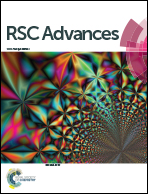Evaluation of surface acetylated and internally quaternized poly(propylene imine) dendrimer as a biocompatible drug carrier for piroxicam as a model drug†
Abstract
Two types of new surface acetylated and internally quaternized poly(propylene imine) (PPI) dendrimers with generation 2 and 3 QPPI-NHAc (G2)/(G3) were prepared and characterized by FT-IR, NMR and MALDI-TOF spectral techniques and then demonstrated as potential and biocompatible drug carriers using piroxicam (PXM, an anti-inflammatory drug) as a model drug. The drug carrying potential of QPPI-NHAc (G2)/(G3) along with their commercial parent dendrimers PPI (G2)/(G3) and linear branched polyethyleneimine (PEI) were investigated in terms of aqueous solubility, in vitro release of PXM and cytotoxicity studies. Pharmacokinetic and biodistribution studies were also carried out in male albino Wistar rats and the efficiency of dendrimer formulation was tested by carrageenan induced paw edema model. The observed results showed that the aqueous solubility of PXM significantly increased in the presence of the higher generation modified dendrimer, namely QPPI-NHAc (G3), to the tune of 50 fold compared with its intrinsic solubility and it is noted that the complexation of PXM with QPPI-NHAc (G3) is responsible for the increased solubility. The degree of complexation was evidenced through UV-Vis and NMR (1H & 2D) spectral analyses. The in vitro release of PXM in the presence of modified dendrimers was remarkably slow as compared to PPI (G3)/(G2) as well as PEI and thus proves their ability for sustained/delayed release of PXM. The cytotoxicity study on Vero cell line was performed through MTT assay and the results reveal that the QPPI-NHAc (G2)/(G3) showed appreciable increase in cell viability and thus indicate the reduced cytotoxicity and improved biocompatibility. Pharmacodynamic results reveal that in the case of QPPI-NHAc (G3)–PXM, 75% of inhibition was observed at the 4th h and this was maintained above 50% until the 8th h compared to plain PXM and proves that when the drug is associated with the dendrimer carrier, it was retained for longer in the bio system. The 2nd, 4th and 8th h organ distribution data showed that a higher recovery of PXM was observed for rat paws with dendrimer–drug formulation QPPI-NHAc (G3)–PXM than plain PXM and it may be concluded that dendrimer–drug formulations not only enhanced the solubility but also controlled the delivery of bioactive material with localized action at the site of inflammation.


 Please wait while we load your content...
Please wait while we load your content...